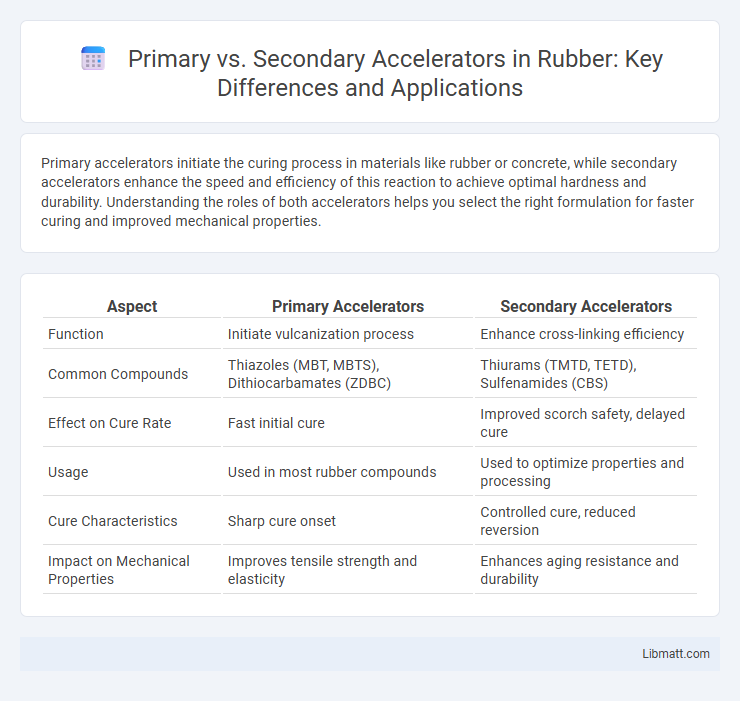Primary accelerators initiate the curing process in materials like rubber or concrete, while secondary accelerators enhance the speed and efficiency of this reaction to achieve optimal hardness and durability. Understanding the roles of both accelerators helps you select the right formulation for faster curing and improved mechanical properties.
Table of Comparison
| Aspect | Primary Accelerators | Secondary Accelerators |
|---|---|---|
| Function | Initiate vulcanization process | Enhance cross-linking efficiency |
| Common Compounds | Thiazoles (MBT, MBTS), Dithiocarbamates (ZDBC) | Thiurams (TMTD, TETD), Sulfenamides (CBS) |
| Effect on Cure Rate | Fast initial cure | Improved scorch safety, delayed cure |
| Usage | Used in most rubber compounds | Used to optimize properties and processing |
| Cure Characteristics | Sharp cure onset | Controlled cure, reduced reversion |
| Impact on Mechanical Properties | Improves tensile strength and elasticity | Enhances aging resistance and durability |
Introduction to Particle Accelerators
Particle accelerators are devices designed to propel charged particles to high speeds using electromagnetic fields. Primary accelerators, such as linear accelerators (linacs) and synchrotrons, generate the initial particle beams with high energy and precision. Secondary accelerators, including booster rings or collision points in colliders, further increase particle energies or direct beams for experiments, enabling advanced research in particle physics.
Defining Primary Accelerators
Primary accelerators are semiconductor materials or devices that initiate the acceleration of charged particles in particle physics or electronics. These accelerators provide the initial energy boost, enabling particles to reach speeds necessary for further acceleration or experimental use. Understanding your primary accelerator's specifications is critical for optimizing overall system performance and achieving desired energy outputs.
Understanding Secondary Accelerators
Secondary accelerators are specialized entities that complement primary accelerators by offering targeted support such as mentorship, sector-specific expertise, or additional funding opportunities. They focus on startups that have progressed beyond initial validation stages, accelerating growth through strategic partnerships and advanced resources. These programs enhance the startup ecosystem by providing tailored guidance and scaling opportunities that primary accelerators may not cover extensively.
Key Differences: Primary vs Secondary Accelerators
Primary accelerators directly increase the pace of economic growth by boosting investment and technological innovation, typically through government policy incentives and infrastructure development. Secondary accelerators enhance the effects of primary accelerators by improving education, workforce skills, and social capital, which in turn support sustained productivity gains. The key difference lies in primary accelerators initiating growth drivers, while secondary accelerators reinforce and sustain the accelerated growth trajectory.
Functions and Roles in Research
Primary accelerators serve as the initial catalyst in research, providing foundational resources, mentorship, and strategic guidance to foster early-stage innovation. Secondary accelerators specialize in scaling and refining research outputs, offering targeted expertise, market validation, and advanced support to bridge the gap between development and commercialization. Your research benefits from engaging both types, ensuring comprehensive development from conceptualization to market readiness.
Technological Components and Design
Primary accelerators integrate core technological components such as particle sources, RF cavities, and magnets within a compact design to maximize energy efficiency and beam stability. Secondary accelerators rely on advanced beam transport systems, precision collimators, and specialized focusing elements to refine and boost particle beams from primary units. Optimizing your accelerator setup requires understanding these design differences to enhance performance and target specific research or industrial applications.
Particle Sources and Acceleration Methods
Primary accelerators generate high-energy particle beams directly using sources like electron guns, ion sources, or laser-plasma interactions, employing acceleration methods such as radiofrequency cavities or electrostatic fields. Secondary accelerators receive particles from primary sources and increase their energy further using magnetic rings, linear accelerators, or synchrotrons. Your understanding of particle sources and acceleration techniques is crucial for optimizing the design and application of these accelerator types in research and industry.
Applications in Science and Industry
Primary accelerators generate high-energy particle beams essential for fundamental research in physics, medical isotope production, and materials science, enabling breakthroughs in cancer treatment and semiconductor manufacturing. Secondary accelerators refine and boost particle energies for specialized uses such as ion implantation and surface modification in industrial processes. Your choice between these accelerators impacts experimental precision and industrial efficiency, tailoring applications to specific scientific or commercial needs.
Advantages and Limitations of Each Type
Primary accelerators offer the advantage of direct energy conversion and typically achieve higher acceleration gradients, making them suitable for compact particle collider designs; however, they are often limited by complex infrastructure and higher operational costs. Secondary accelerators, which boost the energy of particles pre-accelerated by primary systems, provide greater flexibility and can efficiently increase particle energies with lower incremental costs, though they rely heavily on the initial accelerator's performance and have cumulative beam quality degradation. The choice between primary and secondary accelerators depends on factors such as desired energy levels, cost efficiency, and the specific application in particle physics research or medical treatments.
Future Trends in Accelerator Technology
Primary accelerators continue to evolve with advancements in superconducting magnets and high-gradient cavities, enabling higher energy outputs for particle physics research. Secondary accelerators are increasingly integrating compact laser-plasma acceleration techniques, offering efficient and cost-effective solutions for medical and industrial applications. Your access to cutting-edge accelerator technology will expand as future trends emphasize hybrid systems combining both primary and secondary methods for enhanced performance and versatility.
Primary vs Secondary accelerators Infographic

 libmatt.com
libmatt.com